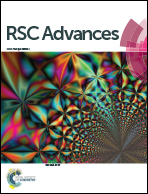Disposable dual sensor array for simultaneous determination of chlorogenic acid and caffeine from coffee†
Abstract
In this work a novel sensor array platform based on a dual carbon screen-printed electrode was developed for the simultaneous determination of chlorogenic acid and caffeine. One of the carbon working electrodes was modified with platinum nanoparticles, reduced graphene oxide and laccase (C-SPE/Pt-NPs/RGO/lacc-biosensor) for chlorogenic acid determination and the second carbon working electrodes was modified with reduced graphene oxide and Nafion (C-SPE/RGO/Nafion-sensor) for caffeine determination. Cyclic voltammetry was used to characterise and optimise the dual sensor array while chronoamperometry was used to investigate the bioelectrocatalytic response. The C-SPE/Pt-NPs/RGO/lacc for biosensing chlorogenic acid exhibited a sensitivity of 0.02 μA μM−1 and a detection limit of 2.67 μM whereas the C-SPE/RGO/Nafion used for sensing caffeine has showed a sensitivity of 1.38 μA μM−1 and a detection limit of 0.22 μM. The developed sensor array was used to determine these two major coffee bean compounds from real coffee samples. Due to its simplicity, feasibility and accessibility, the developed dual sensor array could represent the basis of a valuable analytical tool able to screen both chlorogenic acid and caffeine content from coffee samples offering important information about the phytochemical composition of the samples.



 Please wait while we load your content...
Please wait while we load your content...